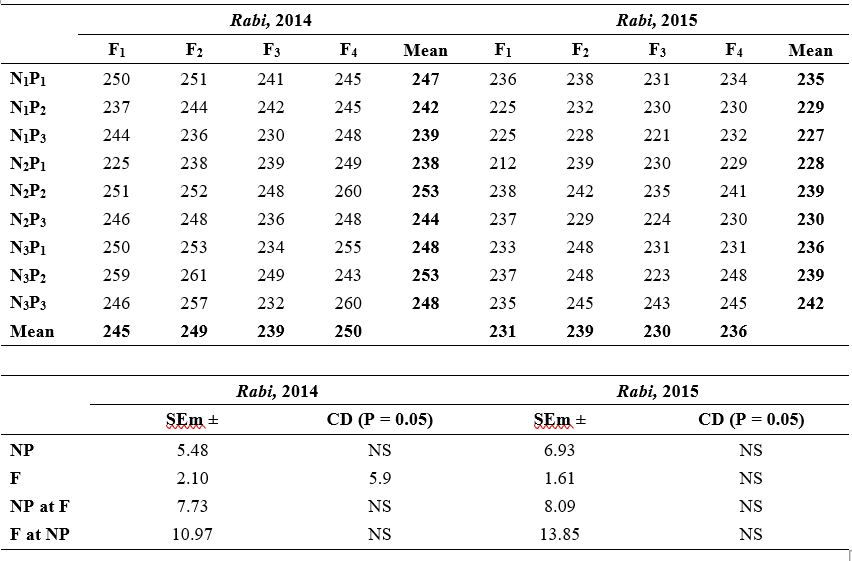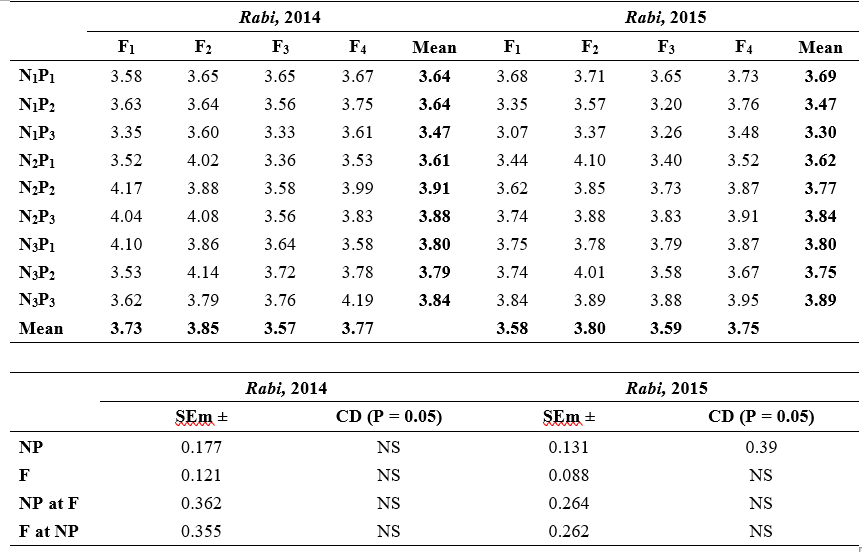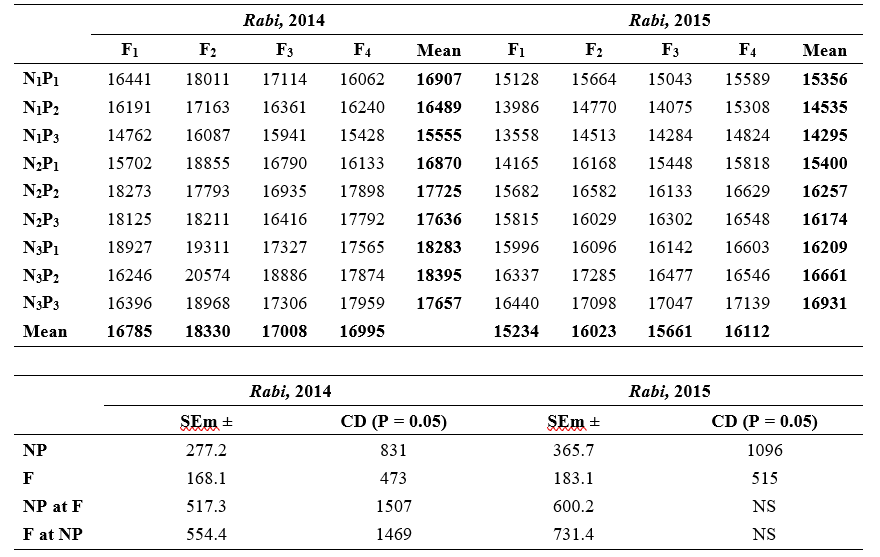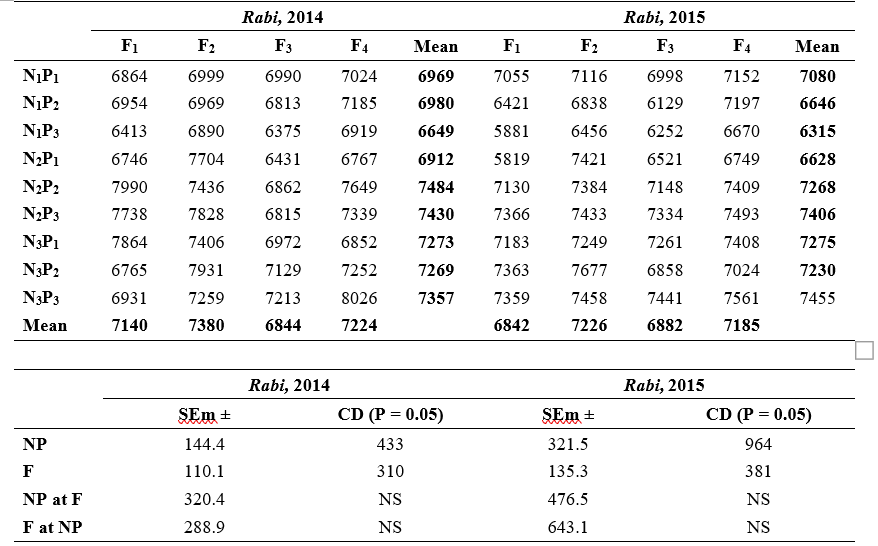Growth and Yield of Maize (Zea Mays L.) As Influenced by Crop Residues, Residual Nutrients and Nutrient Management Practices
0 Views
VIJAYA BHASKAR REDDY UPPALURU*, PRABHAKARA REDDY GADDAM, SRINIVASA REDDY MALLU AND P. KAVITHA
Department of Agronomy, Sugarcane Research Station, Vuyyuru.
ABSTRACT
During rabi, 2014 and 2015 at Agricultural College Farm, Mahanandi plant height of maize differed significantly due
to residual nutrients (main plots), nutrient doses ± crop residues (sub plots) at harvest. Leaf area index differed significantly with respect to nutrient doses ± crop residues at harvest during the second year, but interaction was not significant. There was significant influence of residual nutrients and nutrient doses ± crop residues on the dry matter production of maize. Significantly higher grain yield of maize was recorded in N3P2 and N3P3 in both the years with respect to residual nutrients. With respect to crop residues significantly higher grain yield was recorded with F2 (125% of F1) which was however on par with F4 (F2 + Kharif crop residue incorporation) in both the years.
KEYWORDS: Maize, Nutrient doses, Crop residues, Plant height, Dry matter and Yield.
INTRODUCTION
Maize (Zea mays L.) is an important cereal food crop cultivated both in tropical and temperate regions of the world with the highest production and productivity as compared to rice and wheat. India is the sixth largest producer of maize with 22.36 million tonnes of production from 9.40 million hectares, with a productivity of 2.4 t ha-1. Now it is time to refine agricultural research in the line of cropping system approach, recycling of residues and efficient management of important nutrients like nitrogen and phosphorus particularly for staple food crops of rice, wheat and maize.
Crop residues are the parts of crops left over after the usable portions have been removed. Crop residues incorporated into the soil can serve as a source of nutrient recycling for plant growth and maintenance of soil fertility (Cooperband, 2002). The estimated annual production of crop residues in India is 501 million tonnes, containing 8.02 million tonnes of NPK (MNRE, 2009). Jain (1993) reported that in India, large quantities of crop residues are made available every year and about one third of the residues produced are available for direct recycling on the land and if used can add 2.19 million tonnes of NPK annually.
MATERIAL AND METHODS
The field experiment was conducted at College Farm of Agricultural College, Mahanandi campus of Acharya N.G. Ranga Agricultural University during rabi seasons of 2014 and 2015, situated at 15.51°N latitude, 78.61°E longitude and at an altitude of 233.5 m above the mean sea level, in the scarce rainfall zone of Andhra Pradesh. A composite soil sample was collected at random from 0-30 cm soil depth and analyzed for physico-chemical properties prior to start of the experiments. The soil was sandy loam in texture, neutral in reaction, low in organic carbon and available nitrogen, high in available phosphorus and potassium. The experiment was conducted in the same plots of kharif season and was laid out in a split-plot design with three replications.
Treatments
There were nine main plots consisting of three nitrogen levels and three phosphorus levels of kharif season and four sub plots comprising of fertilizer and crop residue management practices.
Main plot treatments
Nine main plots (residual nutrients) consisting combination of three nitrogen levels 200, 250 and 300 kg N ha-1 (N1, N2 and N3 respectively) and three phosphorus levels 40, 60 and 80 kg P2O5 ha-1 (P1, P2 and P3 respectively) of kharif season.
Sub plot treatments
Four sub plots (nutrient doses ± crop residues) comprising of fertilizer and crop residue management
practices. F1 : Recommended dose of N and P2O5 (250 kg N and 80 kg P2O5 ha-1) F2 : 125% of F1, F3 : F1 +
Kharif crop residue incorporation and F4 : F2 + Kharif crop residue incorporation. A common dose of 60 kg K2O ha-1 was applied to all the plots.
The crop was sown at a spacing of 75 cm × 15 cm. The test cultivar was P-3396 a single cross hybrid with the yield potential ranging from 7.5 to 8.0 t ha-1. After harvest of the economic produce of kharif maize the stover was allowed to dry in the field itself and plot wise weight of the crop residue was recorded.
Plant height was recorded from the five tagged plants in each plot at harvest. It was measured from the base of the plant to the tip of the tassel and the mean plant height was expressed in cm. Leaf area was measured by using LI-COR model LI-300 leaf area meter with transparent conveyor belt (Model I-3050 A) utilizing an electronic digital display. Five plants from gross plot area to measure leaf area in cm2. Leaf area index was calculated by dividing the total leaf area with corresponding land area as per the formula suggested by Watson (1952). Five plants from the destructive sampling area were cut to the base at harvest, sun dried and then oven dried at 60°C till a constant weight was obtained and expressed in kg ha-1. Grain from net plot was sun dried sufficiently, cleaned thoroughly, weighed and expressed in kg ha-1. The data recorded on various parameters during the course of investigation were statistically analyzed following the method of analysis of variance for split- plot design during rabi season as suggested by Panse and Sukhatme (1985).
RESULTS AND DISCUSSION
Plant height
Irrespective of the treatments, plant height of maize progressively increased with age of the crop up to harvest. Variation in plant height was significant with respect to nutrient doses ± crop residues (sub plots) at harvest.
Table 1. Plant height (cm) of rabi maize at harvest as influenced by crop residues and nutrient management practices

Table 2. Leaf area index of rabi maize at harvest as influenced by crop residue and nutrient management practices

There was some evidence of residual nitrogen effect on plant height of maize as higher plant height was observed in N3P2 (300 kg N + 60 kg P2O5 ha-1) in the first year and N3P3 (300 kg N + 80 kg P2O5 ha-1) in the second year, which might be due to the recovery of small percentage of nitrogen applied to previous maize crop. These results are in line with the findings of Felix et al. (2005) on the recovery of N fertilizers.
Application of 125% of recommended dose of N and P2O5 alone or along with crop residues expressed significant effect on plant height, as additional dose of fertilizer nutrients may be required for the mineralization of the incorporated crop residues as well as for the decomposition of the roots of the previous maize. These results are in conformity with the findings of Arshadullah et al. (2012), who documented the requirement of additional dose of nitrogen for rice crop when cultivated with straw incorporation. The lower plant height in 100% recommended dose of N and P2O5 along with crop residues might be due to the fact that un-decomposed residues with wider C: N ratio immobilized the N in the soil and released less N initially to the crop growth.
Leaf area index
Irrespective of the treatments, leaf area index of maize increased progressively with age of the crop.
Effect of residual nitrogen and phosphorus on LAI of succeeding maize was significant in the present investigation and the results are in accordance with the findings of Ahmad et al. (2007). There was evidence for residual effect of nitrogen as maximum LAI was observed in those plots which were supplied with more nitrogen in the previous season, which might be due to the recovery of small per centage of nitrogen applied to the previous maize crop. Similar response to the nitrogen applied in the preceding season was observed by Pandiaraj et al. (2015) on silty loam soils.
Table 3. Dry matter production (kg ha-1) of rabi maize at harvest as influenced by crop residue and nutrient management practices

The highest leaf area index was associated with the application of 125% of recommended dose of N and P2O5 alone (F2), which was however, in parity with the application of 125% of recommended dose of N and P2O5 in combination with crop residue incorporation (F4). Increase in leaf area index with increase in nitrogen levels along with crop residue incorporation was evident due to the favorable effect of nutrients on cell division and enlargement, resulting in production of more number of leaves as well as greater expansion of the individual leaf, there by consistent increase in leaf area per plant. These findings are in conformity with the results of Kiran (2004) and Mala (2008).
Dry matter production
Irrespective of the treatments, dry matter production of maize crop increased progressively with age of crop up to harvest.
Dry matter production differed significantly due to residual nutrient effects (main plots), nutrient doses ± crop residues (sub plots) and their interaction during both the years with exception with respect to interaction in the second year.
Effect of residual nitrogen and phosphorus on dry matter production of succeeding maize was significant and was in accordance with the findings of Verma et al. (2013). There was clear evidence of residual nitrogen effect as maximum dry matter was recorded in those plots which were supplied with more nitrogen in the previous season, which might be due to recovery of nitrogen applied to the previous maize crop. Similar response to the higher nitrogen levels applied in the previous season was observed by Pandiaraj et al. (2015) on silty loam soils. Dry matter production was not significantly affected by the rate of phosphorus applied in preceding season and observed inconsistent dry matter at different P levels. Similar response in soybean in ferralsols of West Kenya was noticed by Vandamme et al. (2014).
Table 4. Grain yield (kg ha-1) of rabi maize as influenced by crop residue and nutrient management practices

Dry matter production of hybrid maize tended to increase progressively with advance in the age of the crop up to harvest. At all stages of crop growth, increasing the nitrogen levels from 100 to 125 % recommended dose of N and P2O5 ha-1 with and without crop residue incorporation resulted in increased dry matter production. Nitrogen, being the major constituent of chlorophyll, whose intensity is known to increase with added N supply, along with other nutrients released by the decomposition of crop residues could have promoted satisfactory plant growth under assured and continuous balanced supply of nutrients. Increased absorption of nutrients might have maintained higher meristematic activity with favorable effect on cell division and enlargement, resulting in increased plant height and production of larger leaves. The increase in source size (leaf area) might have resulted in better light interception and utilization of radiant energy, thereby enhancing the photosynthetic efficiency, which eventually resulted in higher dry matter accumulation under adequate nutrition. Enhanced dry matter production, as evidenced in this investigation corroborates with the previous findings of Kiran (2004), Felix et al. (2005) and Ahmad et al. (2007).
Grain yield
Variation in grain yield was significant due to residual nutrient effects (main plots) and nutrient doses ± crop residues (sub plots) but their interaction was not significant during both the years.
Graded levels of nitrogen exerted favorable influence on grain yield of maize. The highest yield was obtained with the application of 250 kg and 300 kg N ha-1 in the previous season but the response to phosphorus was marginal. Higher level of biomass accrual and efficient translocation of assimilates to the sink due to the sufficient and continuous supply of nitrogen and other nutrients throughout the crop period might be the findings of Kiran (2004).
The highest grain yield of hybrid maize was produced with the application of 125% recommended dose of N and P2O5 alone, however comparable with crop residue incorporation, application of 100% recommended dose of N and P2O5 alone, while it was found to be the lowest with the application of 100% recommended dose of N and P2O5 along with crop residue incorporation. The higher level of grain yield was due to the favourable influence of consistent and adequate availability of nutrients especially nitrogen throughout the crop growth period, which favoured the production of more photosynthates coupled with better partitioning to the sink, under higher level of nutrients. The results are in conformity with the findings of Singh et al. (2000) and Ramu (2005).
Application of 250 kg N and 60 kg P2O5 ha-1 during kharif season and 125% recommended dose of N and P either with or without incorporation of residues of previous season during rabi along with recommended dose of potassium was found to be the optimum fertilizer dose for maize – maize cropping sequence in southern agro climatic zone of Andhra Pradesh.
LITERATURE CITED
Ahmad, N., Amanullah, Jamal, T., Munir, I., Ali, A and Khan, M. 2007. Residual effect of nitrogen applied to maize on yield of barley. Sarhad Journal of Agriculture. 23(3): 549-552.
Arshadullah, M., Ali, A., Hyder, S.I and Khan, A.M. 2012. Effect of wheat residue incorporation along with N starter dose on rice yield and soil health under saline sodic soil. The Journal of Animal and Plant Sciences. 22(3): 753-757.
Cooperband, L. 2002. Building soil organic matter with organic amendments. Centre for Integrated Agricultural Systems (CIAS), College of Agricultural and Life Sciences, University of Wisconsin- Madison. 1-13.
Felix, B.F., Bruce, A.R., William, D.R., Robert, L.T and Robert, B.H. 2005. Recovery of residual fertilizer-N and cotton residue-N by Acala and Pima cotton. Science Society of America Journal. 69: 718-728.
Jain, M.C. 1993. Bio conversion of organic wastes for fuel and manure. Fertilizer News. 35(4): 55-55.
Kiran, K.G. 2004. Effect of groundnut crop residue incorporation and nitrogen management on the performance of succeeding maize (Zea mays L.). M.Sc. (Ag.) Thesis. Acharya N.G. Ranga Agricultural University, Hyderabad, Andhra Pradesh.
Mala, S. 2008. Response of hybrid maize to crop residue incorporation in combination with graded levels of nitrogen. Ph.D Thesis. Acharya N.G. Ranga Agricultural University, Hyderabad, Andhra Pradesh.
MNRE, 2009. Ministry of New and Renewable Energy. Government of India, New Delhi. www.mnre.gov. in/biomass resources.
Pandiaraj, T., Selvaraj, S and Ramu, N. 2015. Effects of crop residue management and nitrogen fertilizer on soil nitrogen and carbon content and productivity of wheat (Triticum aestivum L.) in two cropping systems. Journal of Agricultural Science and Technology. 17: 249-260.
Panse, V.G and Sukhatme, P.V. 1985. Statistical Methods for Agricultural Workers. Indian Council of Agricultural Research, New Delhi. 205-210.
Ramu, Y.R. 2005. Agrotechniques for enhancing productivity and quality of hybrid maize (Zea mays L.). Ph.D Thesis. Acharya N.G. Ranga Agricultural University, Hyderabad, Andhra Pradesh.
Singh, D.P., Rana, N.S and Singh, R.P. 2000. Dry matter production and nitrogen uptake in winter maize (Zea mays) based intercropping system under different levels of nitrogen. Indian Journal of Agronomy. 45(4): 676-680.
Vandamme, E., Pypers, P., Vanlauwe, B., Baijukya, F and Merckx, R.S. 2014. Residual phosphorus effects in soybean–maize rotations on a P-deficient Ferralsol. Nutrient Cycling in Agroecosystems. 98: 187–201.
Verma, N.K and Pandey, B.K. 2013. Effect of varying rice residue management practices on growth and yield of wheat and soil organic carbon in rice-wheat sequence. Global Journal of Science, Frontier Research in Agriculture and Veterinary Sciences. 13(3): 33-38.
Watson, D.J. 1952. The physiological basis of variation
in yield. Advances in Agronomy. 4: 101-105.
- Genetic Diversity Analysis of 64 Maize Inbred Lines for Yield Traits Using D2 Statistics and Principal Component Analysis
- Effect of Border Crops on Activity of Predatory Fauna In Blackgram (Vigna Mungo L.)
- Effect of Organic Nutrient Management Practices on Growth and Yield of Foxtail Millet
- Species Diversity of Sugarcane Shootborers in Major Sugarcane Growing Districts of Andhra Pradesh
- Faunistic Studies on Economically Important Lepidopterans in Different Field Crops of Tirupati District
- Production Potential of Sweet Corn as Influenced by Organic Manures and Foliar Nutrition

